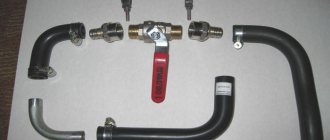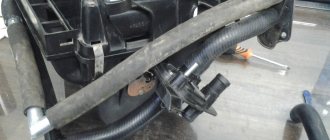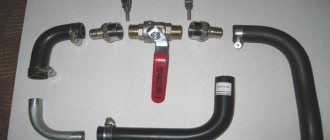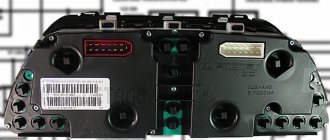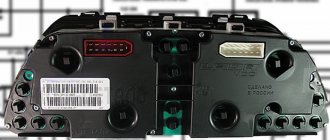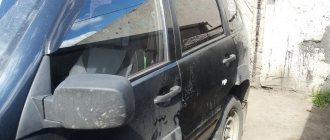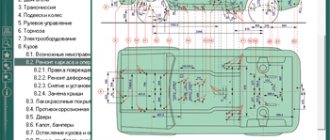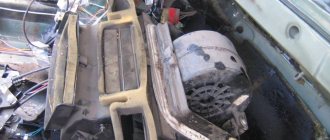Failure of the stove motor on a classic is one of the common problems of the heating and ventilation system. But, more often than not, car enthusiasts are faced with the fact that the fan motor starts to whistle, squeak, and there is a hum and other strange sounds.
In these cases, it is possible to restore normal operation of the motor for a while. To do this, you should disassemble the engine, wash it from dirt, dust and lubricate the bushings and other rubbing parts with graphite lubricant. Litol-24 lubricant is suitable for bearings.
Note: the heater motor on bearings is more reliable and less noisy compared to a motor on bushings.
You should also make sure that the impeller does not touch the housing (casing). If necessary, sharpen the blades slightly.
Stove motor with impeller VAZ 2101-2107, Oka, Niva
The process of refining the heating system
It is useful to note that modification of the VAZ-2121 stove is not accompanied by high problems. Even a car enthusiast who does not have special technical and repair skills can eliminate such technical defects.
In addition, modification of the Niva-2121 stove may involve performing a variety of actions, including the most basic ones.
Heating in your car can be improved by even just slightly upgrading the air ducts. If you want to radically improve the heating system and increase comfort, then, of course, you will have to tinker a little more.
Fault Diagnosis
The stove supplied as standard will need to be modified for preventive purposes. The procedure will not take much time, but it will prevent many problems in the future. Driving experience suggests that the first severe frosts will undermine the “health” of the device. The list of main weaknesses is as follows:
- the optimal operating temperature range for model 2121 is from -5 to +10°C;
- inability to warm up the air in the cabin if outside is -8°C or lower;
- when the blowing power increases, the temperature does not increase;
- When driving in 2nd gear, the noise from the Niva's stove becomes significant.
That is why it is better to take the necessary measures in advance. The driver has few alternatives. On the one hand, everything remains in its place. The heating device is used at minimum power. During mild winters this is still tolerable, but with the onset of real cold weather the conditions will become unbearable. On the other hand, it's easy to spend a few hours rectifying the situation.
Further developments proceed as follows. If the heating in the car is running at ½ power, you can limit yourself to minor repairs. The main thing is to make sure that there are no noises or extraneous knocks, otherwise the Niva 21213 should immediately go for a technical inspection.
The presence of an unpleasant sound indicates the need to replace the device. A specialized retail network offers ready-made options for heating mechanisms for Niva. If desired, it can be assembled independently.
The second option is considered more preferable. When you assemble it yourself, you have the opportunity to literally personalize the stove. To do the work yourself, you will need to visit a specialized store or market to buy spare parts.
When purchasing, original parts or analogues are selected. The main thing is that they have a quality certificate. Otherwise, they cannot be installed. It would be useful to rewrite the technical data of the vehicle so as not to exceed the parameters recommended by the manufacturer.
Air duct modernization
Unfortunately, if you carefully examine the air ducts that your Niva is equipped with, you will be horrified at how it was possible to install so many cracks in it. Is it possible to expect good heating with such a design?
The answer, of course, is simple, since all the heated air is dispersed under the dashboard, and the interior is heated according to the residual principle.
However, it’s good when a problem is so easily identified, then solving it is much easier. Upgrading the air duct involves applying silicone glue to all joints.
Be prepared for the fact that performing such actions is sometimes quite difficult, since not all places have unobstructed access. You still have to get used to it and apply silicone glue to all the joints.
Engine pump faulty
A pump is essentially a mechanical (sometimes electric) engine pump that pumps hot liquid through the system. That is, from the power unit block, through the pipes and further into the radiators for cooling. And in our case, for heating the interior.
It is an “impeller” that is inserted into a metal cylinder through which liquid passes. The impeller rotates, thereby pushing antifreeze (TOSOL) through the system. If there were no pump, then cooling the motor would be extremely ineffective, it would quickly overheat.
Very often, the pump is driven by a belt drive from the crankshaft of the power unit.
The main breakdowns are:
- Sometimes the crankshaft belt breaks, the pump does not rotate and does not circulate the coolant through the system. Accordingly, the stove does not heat. However, the power unit will also overheat.
- The pump itself is jamming. It does not rotate, or the internal part of the “impeller” does not rotate.
- Eats the inside. Due to the “crappy” quality of the metal, the internal impeller can be eaten away by aggressive antifreeze or antifreeze. Therefore, purely physically, the pump pulley rotates, but the liquid pumps through the system very poorly. Again, the stove does not heat.
For all reasons, the pump needs to be changed. I’ll say right away that the first “bells” may be a whistling sound in the engine compartment, a hot hose before the pump or heater, but a cold one after.
Fan replacement
Experienced car owners recommend not stopping there and continuing to modify the stove by tuning the fan.
Some people suggest getting rid of the fan installed by the manufacturer and installing a figure eight fan instead.
If you also decide to carry out such a replacement, you need to additionally decide whether you will leave the original control of the stove or also replace it with a “eight” analogue.
Having decided on the second option, take care of purchasing the following additional items:
- fan speed switch;
- additional resistor for the stove.
So, after you have completely prepared all the necessary components, you can proceed directly to the process of modifying the fan.
Initially, you should dismantle the old air supply box. Unfortunately, despite the fact that this requires unscrewing only four nuts, it will not be possible to do this without outside help. Your partner will need to hold the screws under the hood while you unscrew them using a wrench.
After this, you can easily remove the air intake. Clean it if it needs it, and then cut away a small amount of the plastic to provide enough space for the new fan to operate.
Engine thermostat faulty
Now about more complex breakdowns. If everything is fine with the stove itself, the fan works, but does not heat well, then the problem may be in the engine thermostat.
The thermostat serves to regulate the so-called “cooling circles”. When we start the engine, the coolant circulates in a “small circle”; the engine and the interior heater are involved here. Thus, warming up occurs much faster. After the coolant has warmed up, the thermostat opens a “large circle” and the heated liquid has already flowed to the main radiator, which is located under the hood. This is done in order not to overheat the motor if there is excessive overheating.
BUT, depending on time or the quality of the coolant, the thermostat may fail and not close the “big circle”, but always drive around it. Sometimes an absurd situation even happens when the small circle is (even) slightly blocked and weakly heated antifreeze flows into the stove (which should warm up the interior). It is blown to the maximum (maximum speed), but the air flows cold or barely warm. And since at -20, -30 degrees it takes a very long time to wait for the “big circle” to warm up (and it may not warm up thoroughly at all), the interior will not warm up.
The only solution is to replace the thermostat! Moreover, the faster, the better; nevertheless, the glass in your cabin will also not thaw, which is fraught in winter, because visibility deteriorates.
Replacing the faucet
Unfortunately, the culprits for poor heating of the Niva can be not only the fan and air duct, but also the faucet of the stove itself. In particular, its diameter is incredibly small, which contributes to the slow spread of liquid throughout the radiator.
It is for this reason that many car owners decide on yet another additional tuning for heating the interior of their beloved Niva, which involves replacing the tap.
The crane will, of course, have to be borrowed from other vehicles. Many foreign cars can act as “donors” to solve this problem, but the best from a financial point of view are cranes removed from Volkswagen or Opel.
Initially, you will have to remove the old faucet. This process is labor-intensive, so it is important to follow the algorithm recommended by those car owners who previously had to modify the heating system themselves, and the result was effective.
Open the hood, find the clamp that secures the hose to the pipe, and try to loosen it using pliers. Masters recommend performing such actions with gloves, since when performing such actions you have to make an effort, the hand often breaks and can be damaged if it is not wearing gloves.
Your next task will be to disconnect the seal; you just need to unscrew the screws that secure this seal to the partition. Next, all that remains is to simply remove this seal. The storage shelf can be removed in the same way, and nothing prevents such actions from being performed.
Now go from the interior side and slightly loosen the tap screw. Next, it will be easy to remove the cable from the crane lever.
Now you have come directly to the tap itself, unscrew the screws that hold it in place. Depending on the configuration of the stove radiator, the quantity may vary, and nuts may be installed instead of screws.
Remove the tap, remove the pipe from it, also first unscrewing the nuts.
Next, pick up the new faucet that you prepared in advance and install it in the car, using the same algorithm only in reverse order.
Masters only recommend using a little trick. When attaching the faucet to the radiator, the nuts are very often unscrewed, and accordingly, they get lost while the car is moving. To prevent such “losses”, it is recommended not just to tighten the nuts, but to first place them on plasticine.
So, the process of upgrading the heating system can be carried out by anyone, and in gratitude he will receive comfortable conditions inside the cabin even in those moments when the frost outside is fierce.
Reg.: 12/06/2004 Threads / Messages: 628 / 51730
Reg.: 05.27.2005 Threads / Messages: 3 / 929 From: Moscow Age: 41 Car: VAZ 21213. 2002
questions)? in PM
Reg.: 03/16/2005 Topics / Messages: 20 / 564 From: Krasnoyarsk Age: 36 Car: Niva 2121 93 g, 1.6 l, Ozone, I-511, 4-speed gearbox, ReShniva GLC 2012, 1.7i
Reg.: 12/06/2004 Threads / Messages: 628 / 51730
Reg.: 08/13/2005 Threads / Messages: 2 / 478 Age: 37 Car: 21213 97 years old
Reg.: 02.17.2005 Threads / Messages: 2 / 235 From: SPb Age: 46 Car: 21213, 1999 + 21310, 2011
Reg.: 08/13/2005 Threads / Messages: 2 / 478 Age: 37 Car: 21213 97 years old
Reg.: 02.17.2005 Threads / Messages: 2 / 235 From: SPb Age: 46 Car: 21213, 1999 + 21310, 2011
Let's think like this. Are Niva's with a standard engine cooling system, or interior heating, known? Known. So it is technically possible. If you are cold, then something is not working for you. The cooling system is not that big. So check everything around and you will find the culprit. And you will be happy
btw, this year in the fall I figured it out: as soon as the windshield stops fogging up, I switch the airflow to the central nozzles so that the hot air immediately hits me, and does not first cool down on the glass. I heat up much faster
Reg.: 07.28.2005 Threads / Messages: 1 / 2646 From: Ivanovo Age: 43 Car: Nivka2121. g.v. worn-out 1.9i and other minor tuning Murzik MV 300TD 1993
| 45 posts on previous pages |
Heater radiator is clogged
There may be several reasons:
The first is improper mixing of antifreeze and antifreeze . For example, in G13 you filled in, say, G11 or even antifreeze, then a sediment may appear that will quickly clog all the thin radiator pipes.
Secondly, they poured water. Water not only causes rusting of metals in the system, but also forms scale on the walls.
Third, they eliminated leaks in the heater radiator or main radiator using all kinds of sealants. On the one hand we heal, on the other we cripple. The passages in the radiator can become clogged with excess of this sealant; the liquid cannot circulate normally in it and, accordingly, heat it up, which means it will not really heat it. True, your engine may show high temperatures, at the limit level (the main thing is not to overheat it). You need to either flush the system, clean the radiator, or simply replace the radiator.
